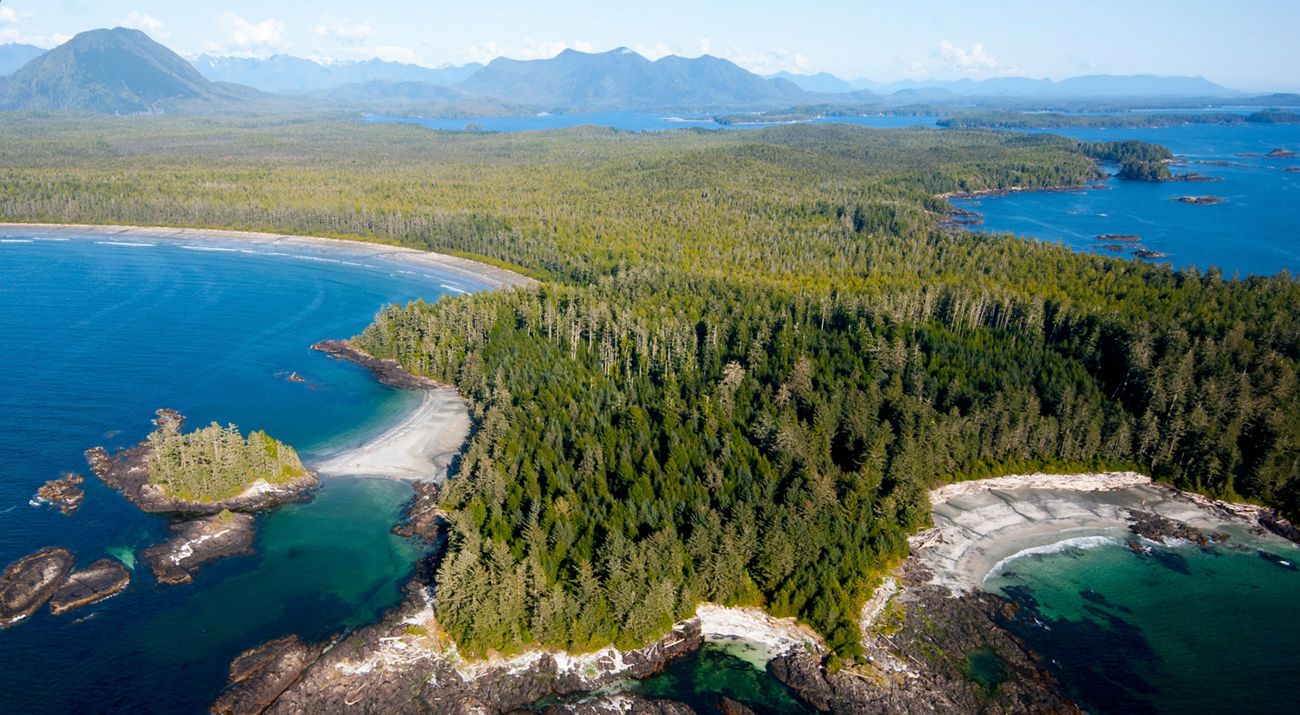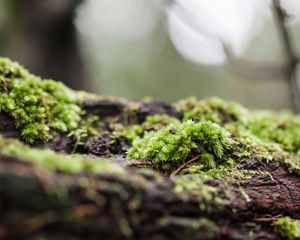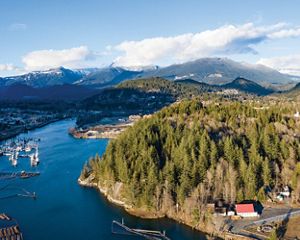The Power of the Emerald Edge
Community, conservation and climate action in the world’s largest temperate rainforest.
A Culture of Conservation
Watch our new film to hear from Indigenous leaders and how we’re working in partnership in the Emerald Edge.
If the Emerald Edge is a place you don’t already know, allow me to help make an introduction. It is a landscape of stunning biodiversity on North America’s Pacific Coast, spanning the coastlines of Oregon, Washington state, British Columbia and Southeast Alaska. It encompasses more than 100 million acres of coastal rainforest, thousands of rivers and salmon streams, 40,000 islands and 35,000 miles of coastline. And it is home to Indigenous First Nations, Alaska Native peoples and coastal Tribes, and they have been stewards of this landscape for millennia.
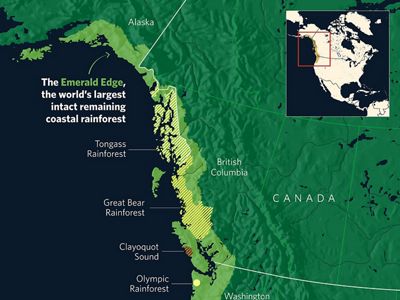
Over years of working in partnership, I have learned that we need to do conservation differently with Indigenous communities throughout the Emerald Edge and globally to put community well-being, cultural vibrancy and sustainable development first and trust that conservation will follow. By working side-by-side to understand shared priorities and learning how Nature United can best support our partners, we can achieve much more together — and create outcomes that are meaningful for local communities and solve complex global challenges, such as the dual climate and biodiversity crises.
Primer on Forest Carbon
How Canada’s Boreal Forest can be a powerful solution for climate change.
Read MoreThis region and its old-growth forests of thousand-year-old trees — towering giants such as Sitka spruce and cedar and hemlock — are a carbon storehouse of staggering proportion, making it a powerful ally in tackling the climate crisis. The forests of the Emerald Edge sequester more than 300 million tons of carbon per year, which is equal to the annual energy use of nearly 58 million homes. That’s more than the population of all of Canada, plus Washington state, Oregon and Alaska combined. And protecting forests for their carbon-storage capabilities does more than provide one more tool for addressing the climate crisis: It also creates more resilient, biodiverse ecosystems and vibrant and healthy human communities.
Cedar’s Story
Nature's Guardians
Indigenous Peoples and local communities have long protected their lands and waters in reciprocity with nature, often guided by deep connections to place, culture and ways of knowing.
In fact, lands stewarded by Indigenous Peoples hold 17 percent of the world’s remaining forest carbon and 80 percent of global biodiversity. What these figures tell us is that Indigenous stewardship and management often achieve greater conservation results and sustain more biodiversity than government-protected areas such as national parks or reserves.
We know from evidence like this that working in partnership with Indigenous Peoples to support local vision and leadership is one of the most enduring steps for securing a thriving future. Without the contributions of Indigenous knowledge and stewardship, even the most well-intentioned efforts to seek longstanding balance for people and nature in the places where we live and work are unlikely to succeed. And as Indigenous partners have patiently helped us to understand through conversation and time together, short-term gains are not wins for people or for nature. But long-term stability for people and nature is.
Quote
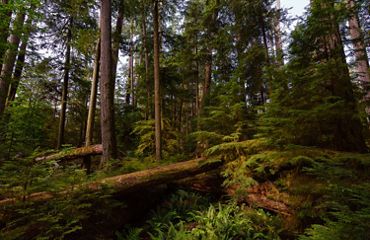
It is incredibly important that together we protect this coastal temperate rainforest and lay the foundation for a sustainable economy that will support First Nations and local communities into the future.
Long-Term Conservation in Clayoquot Sound
With local partners, we are closing in on a mutual goal in Clayoquot Sound in British Columbia. This place within the Emerald Edge is home to three First Nations: Ahousaht, Tla-o-qui-aht and Hesquiaht, stewards of this stunning mosaic of emerald valleys, clustered islands and thousand-year-old trees. In 2000, the area became British Columbia’s first UNESCO World Biosphere Reserve.
Yet despite its significance, Clayoquot Sound is vulnerable to unsustainable logging, mining and other development. It is incredibly important that together we protect this coastal temperate rainforest and lay the foundation for a sustainable economy that will support First Nations and local communities into the future. And protecting these forests will ensure that the carbon they hold stays sequestered — to be sure, we need these forests to not only hold onto this existing carbon, but to sequester even more.
Fortunately, there’s a way forward. In an era when we seem to be tasked with the impossible, a pathway exists for keeping the carbon-storing potential and biodiversity of Clayoquot Sound and forests throughout the Emerald Edge up and running.
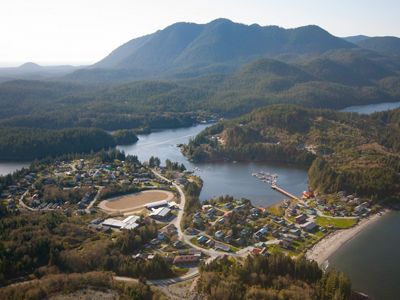
In late 2020, the provincial government of British Columbia, Canada, implemented a deferral of old-growth logging in much of Clayoquot Sound on Vancouver Island and engaged the First Nations in dialogue about land-use visioning to move the region from commercial forestry to protection and sustainable management, a major victory for the First Nations.
Now, these Nations are getting very close to realizing land-use visions that will result in additional conservation and new forest management areas. Combined, the visions of the First Nations will permanently conserve more around three-quarters of Clayoquot Sound and lay the foundation for a sustainable economy that will support the First Nations of that place into the future. Nature United’s commitment is to fundraise for stewardship endowments for the First Nations, for costs of the forestry tenures and other capacity funding for the First Nations.
Strong Economies, Rights and Authority
Throughout the Emerald Edge, we support sustainable economies by helping local partners create sustainable economic models that benefit local communities, and also by working to diversify local revenue streams. Nature United aims to address and solve barriers to sustainable economic development by providing capacity-building resources that offer communities and Indigenous Peoples new skills, which draw on their experiences, cultural heritage, deep knowledge of place and resources to align cultural and ecological values.
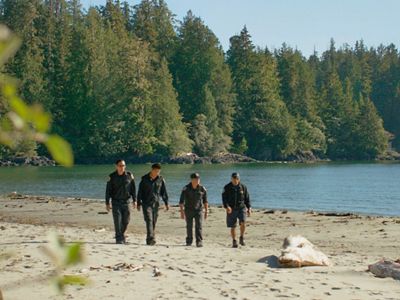
We know that when Indigenous communities have the capacity and resources they need to manage the lands and waters in their territories, conservation results are effective, long-lasting, and supportive of social and economic well-being. Our shared vision is a sustainable region that is managed for and by its people. We are identifying models that increase Indigenous authority in decision-making, stewardship and economic diversification.
Following the lead of local partners, we are respecting Indigenous rights and authority through the design and financing of land protection that will secure a world-class, Indigenous-led conservation strategy. In the two decades of working in the Emerald Edge, we have seen the transformative impact of deep, trust-based partnerships between Indigenous Peoples, local communities and conservation groups, producing lasting benefits for both people and the planet.
NEW FILM PREMIERING APRIL 20, 2023
The Emerald Edge: A Culture of Conservation
Nature United and its global affiliate The Nature Conservancy work together across the Emerald Edge to advance these priorities for our partners.
